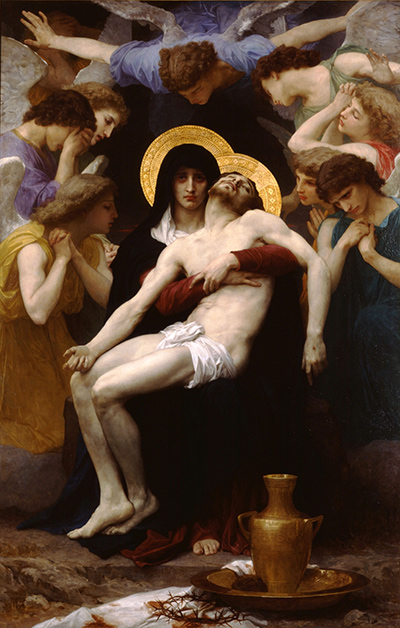The Pieta, 1876 by William Adolphe Bouguereau (1825−1905) is, at first sight, set firmly within the traditions of Christian religious imagery. However, even the most cursory glance reveals that this is far from being a standard interpretation of Mary and Christ the Redeemer.
The body cradled in Mary’s arms leads the eye to her face and there it stops, transfixed.
This is no acquiescent servant humbly offering her son.
The red-rimmed eyes stare at us from the canvas. Their expression is not one of acceptance, but one of rage, incomprehension, and disbelief.
This mother asks why her only son has been torn away from her. This canvas is not a depiction of an abstract religious event; it is a scream. It is a depiction of the most intensely personal, devastating and incomprehensible event: the loss of a child – Bouguereau’s eldest son Georges.
When Georges died at the age of sixteen, on July 19, 1875, Bouguereau sank into a deep depression for six months. In order to escape this state, he resolved to create a work that would mark his sorrow and be a memorial to his dead son.
The Pieta, 1876 was the result.
The extraordinary power of this canvas comes from the dynamic created between the classical techniques the artist is using and the raw power of his emotions.
Bouguereau personalises the participants in this terrible event. The angels are no ciphers; they are individual characters showing individual responses. Mary is primarily a mother who has lost her only son.
This personal tribute to the overwhelming despair of a bereft parent is contained and concentrated within a classical format.The formality of the construction: the rainbow of angels, the detailed, almost photo-realist, wine jug, enables the viewer to feel the pain and yet not be swept away by it.
This is no idealisation of the death of Christ – this is real.
Bouguereau was the son of a wine merchant. He began his career by painting portraits of local parishioners. He then studied in Paris, where he was attracted by the academic school, which centred on classical and religious subjects. He particularly admired Raphael and attempted to emulate both his style and techniques. He was deeply traditional in his approach achieving highly realistic depictions of the human, often female and partially naked, form. Michelangelo produced his own Pieta sculpture.
He became successful early and apparently effortlessly. His work was enormously popular and he received both secular and religious commissions in large numbers. He was made Commander of the Legion of Honour in 1885
He represented everything that the modernists fought against. Paul Gauguin, who rated him at zero, said that his paintings belonged in a brothel. Degas even created a word "Bouguereauté,” which he used to describe work that depended on “slick and artificial surfaces.”
After 1920 Bouguereau’s work fell into disrepute as American millionaires moved on to the Impressionists and his canvases disappeared into museum basements.
In the 1970’s a re-appraisal began and since then his work has re-established itself and prices have risen steadily.
On the 9 June 2010, The Pieta, 1876 was sold for $2,777,500.
Bouguereau’s work is sometimes criticised as lacking in content and he acknowledged that his later paintings were often driven by public taste. However, The Pieta, 1876 cannot be criticised on either of these scores. It is an intensely personal piece of work, whose power is increased by being contained within the classical tradition.
The Pieta, 1876 encapsulates the agony of the grieving parent and simultaneously presents an image of exceptional beauty.




